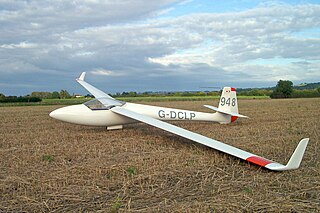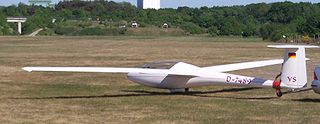Libelle may refer to:
Libelle may refer to:

The Dornier Do 12 Libelle III was the third of a line of small German flying boats of the 1930s. It started with the Dornier A Libelle I and the Dornier A Libelle II, though the Do 12 was not a continuation, but an entirely new aircraft.
A dragonfly is a flying insect of the order Odonata.

The Glasflügel 201 Standard Libelle is an early composite Standard Class single-seat sailplane produced by Glasflügel from 1967.
The firm Glasflügel was founded by Eugen Hänle in 1962 and was located in Schlattstall, south of Kirchheim unter Teck. It was the first firm to manufacture a glass-fibre sailplane in large numbers. It was also responsible for a large number of innovations in sailplane design and technology: quick assembly systems for wings and tailplane, automatic control connections, trailing edge airbrake-flap combinations, hinged instrument panels, the parallelogram control stick and automatic trimming are some innovations introduced by Glasflügel and later adopted by other manufacturers. Some of these are standard features in nearly all gliders produced today.

The Glasflügel 303 Mosquito is a composite 15 metre Class single-seat sailplane manufactured by Glasflügel between 1976 and 1980.

The Glasflügel H-301 Libelle is an early composite single-seat sailplane produced by Glasflügel from 1964 to 1969. The H-301 had camber-changing wing flaps so was required to compete in the Open Class because the Standard Class excluded wing flaps. It was often known as the Open Class Libelle.

The National Soaring Museum (NSM) is an aviation museum whose stated aim is to preserve the history of motorless flight. It is located on top of Harris Hill near Elmira, New York, United States.

The Dornier Libelle, also designated Do A, was a German open-cockpit, all-metal, parasol wing, monoplane flying boat aircraft, with partly fabric-covered wings. A landplane version, built without sponsons and fitted with a fixed tailwheel undercarriage was produced as the Dornier Spatz.

The Glasflügel 206 Hornet is a Standard Class sailplane produced in Germany between 1975 and 1979. Of conventional sailplane design with a T-tail, it replaced the Standard Libelle, featuring composite construction throughout. Differences from the earlier aircraft included a redesigned canopy, retractable monowheel landing gear, and provision for 100 kg (220 lbs) of water ballast.

The Glasflügel BS-1, sometimes called the Björn Stender BS-1 or the Stender BS-1, is a West German, high-wing, single seat, T-tailed, FAI Open Class glider that was designed by Björn Stender and produced by Glasflügel.

The FFA Diamant is a family of Swiss high-wing, T-tailed, single-seat, FAI Standard Class and FAI Open Class gliders that was designed by engineering students under supervision of Professor Rauscher at the ETH Zurich and manufactured by Flug- und Fahrzeugwerke Altenrhein AG (FFA) of Altenrhein, Switzerland.

The Glasflügel 205 Club Libelle is a high wing, T-tailed, single seat glider that was designed and produced in West Germany by Glasflügel for club and rental use.
The Hütter H28, also called the Hutter 28, is a German mid-wing, single seat, glider that was designed by brothers Ulrich Hütter and Wolfgang Hütter in the 1930s.
Falke is German for hawk. It may refer to:

The Deutsches Segelflugmuseum mit Modellflug, situated on the Wasserkuppe in the German state of Hesse is the national gliding museum, opened in 1987.

Libelle is a Flemish weekly lifestyle and women's magazine based in Mechelen, Belgium. The magazine is the spin-off the magazine with the same name, Libelle, published in the Netherlands.

Libelle is a weekly women's magazine published in Amsterdam, Netherlands. It has been in circulation since 1934.